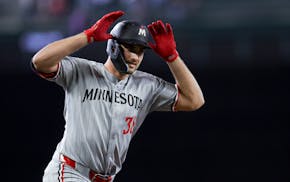After committing more than $300 million of contracts to veteran players during a free agency bonanza, the Vikings are preparing for what figures to be a quieter draft than usual. It's certainly not likely to rival last year's frenzy, when the Vikings moved up one spot to No. 10 to make J.J. McCarthy the highest-drafted quarterback in franchise history and moved up another six spots (from the No. 23 pick they'd already acquired in another trade) to select edge rusher Dallas Turner.
They begin with only four picks: No. 24 (first round), No. 97 (third round), No. 139 (fifth round) and No. 187 (sixth round). But the Vikings figure to be active, both in terms of building their draft supply and filling needs on a veteran roster that's moving forward with a second-year quarterback.
The draft will be televised on ABC, ESPN and NFL Network on Thursday (Round 1, 7 p.m.), Friday (Rounds 2-3, 6 p.m.) and Saturday (Rounds 4-7, 11 a.m.).
First round: No. 27 overall (mock trade with Ravens)
Acquired with Nos. 91 and 136 from Baltimore in exchange for No. 24.
Malaki Starks, S, Georgia. He's played safety, nickel and corner, showing he can move into the box, handle deep coverage and master a defense. Starks was one of the key communicators in Kirby Smart's check-based defense at Georgia. "They do a really good job of having different things [in their defense]," Starks said of the Bulldogs in a predraft media availability outside Lambeau Field on Wednesday. "It think it prepared me to play any system."
Sound like a player who'd be a fit for Brian Flores? With Harrison Smith possibly in his last season, Josh Metellus in a contract year and Camryn Bynum in Indianapolis, the Vikings could use another investment at a position group Flores features. Starks said Wednesday he had a "really good interview" with the Vikings at the combine, spending time with coach Kevin O'Connell and General Manager Kwesi Adofo-Mensah. He could be a match for them in the first round.
Other possibilities:
Grey Zabel, OL, North Dakota State. He's played all five line positions in college, and could be the Vikings' first-round pick if they wanted to put him at left guard as the final piece of their offensive line makeover. He was a tackle in college, but his size (6-6, 305) makes him a better fit to play guard in the NFL.
Derrick Harmon, DT, Oregon: The Vikings visited with him at the combine, and are believed to be interested in Harmon, who showed quickness and smarts to succeed as a pass rusher for the Ducks last season. Even after signing Jonathan Allen and Javon Hargrave, the Vikings have continued to do their homework at defensive tackle; Harmon could be their choice in the first round.
Third round: No. 91 overall
Acquired with Nos. 27 and 136 from Baltimore in exchange for No. 24.
Jonah Savaiinaea, OL, Arizona. He visited Minnesota on a top-30 prospect trip this month, after playing both tackle spots and right guard in college. The 6-4, 336-pound lineman might become a guard in the NFL; the Vikings would work with him to develop enough strength to adequately handle the tackles he'd face in the league.
Other possibilities:
Kyle Williams, WR, Washington State. He's only 5-11, but the versatility he's shown to play across the formation could make him an intriguing target for the Vikings, who might need another young wide receiver. Williams ran a 4.4-second 40-yard dash, and while he'd need to improve his footwork in the NFL, his deep speed and versatility could catch the Vikings' eye.
Jordan Phillips, DT, Maryland. Phillips measured only 6-1 at the combine, but led all defensive linemen with 29 bench press reps. He said at the combine he models his game after Javon Hargrave; the Vikings could draft Phillips to learn under Hargrave at the beginning of his career before eventually succeeding him.
Third round: No. 97 overall
Jordan Hancock, CB, Ohio State. Even after bringing back Byron Murphy Jr., signing Isaiah Rodgers and adding Jeff Okudah in free agency, the Vikings could follow the old Mike Zimmer axiom about cornerbacks and add "just one more" here. Hancock would give them a competitive cover corner who can play multiple spots in the defense and flashed a 41½-inch vertical at Ohio State's pro day.
Other possibilities:
Jonas Sanker, S, Virginia. If the Vikings don't address safety in the first round, they could come back to the position on Day 2 with Sanker, who's impressed scouts with his professionalism. He had shoulder surgery before the 2023 season, and the Vikings would have to feel good about his tackling ability after the injury.
Marcus Mbow, G, Purdue. The Vikings brought Mbow to Minnesota on a top-30 prospect visit, and could take a look at him in the third round as the final piece of their offensive line overhaul. He's on the smaller side (6-4, 305), which could lead to concerns about how he'll handle NFL defensive tackles, but he's shown good movement skill that should help in the run game.
Fifth round: No. 136 overall
Acquired with Nos. 27 and 91 from Baltimore in exchange for No. 24.
Brashard Smith, RB, SMU. The Vikings brought the 5-10 speedster in for a top-30 visit, after he ran for 1,332 yards and 14 touchdowns following his transfer from Miami last season. He switched positions from receiver to running back at SMU and ran a 4.39 40 at the combine; he could join Aaron Jones and Jordan Mason as a big-play option in the backfield.
Other possibilities:
Ty Robinson, DT, Nebraska. Robinson posted seven sacks last year at Nebraska, largely as a product of his hustle and strong hands. He's not the longest-armed tackle, but he makes up for some of his stocky build with his physical playing style.
R.J. Mickens, S, Clemson. Mickens' father, Ray, was a 10-year NFL cornerback who intercepted 11 passes in 146 games; the younger Mickens showed strong instincts as a coverage safety at Clemson, before running a 4.49 40 at the combine. He's built better to be a deep safety than an in-the-box force.
Fifth round: No. 139 overall
Kaimon Rucker, OLB, North Carolina. Rucker is only 6-2, which might lead teams to shy away from him as an edge rusher, but he posted a pass rush win rate of 18.6%, according to Pro Football Focus. His size and struggles against the run mean he'd likely be a pass rush specialist in the NFL, but after losing Pat Jones II in free agency, the Vikings could use some pass rush depth.
Other possibilities:
Jalen Rivers, T, Miami. Rivers might fit best as a guard in the NFL, given the fact he's only 6-5, but he could play tackle in a pinch, and use his technique to succeed at the next level. He's dealt with injuries throughout his college career, so the Vikings would have to feel good about him from a medical perspective.
Oronde Gadsden II, TE, Syracuse. The Vikings brought Gadsden in on a top-30 visit; he's the son of former Dolphins receiver Oronde Gadsden, and he'd likely join the team as a receiving tight end who'd have some work to do in the blocking game.
Sixth round: No. 187 overall
Benjamin Yurosek, TE, Georgia. The 6-4, 245-pound tight end is a strong blocker who's shown he can box out defenders for contested catches. He's unlikely to be a dynamic playmaker in the NFL, and might benefit from adding some size to last as a blocker, but he could develop as a third tight end for the Vikings.
Other possibilities:
Da'Quan Felton, WR, Virginia Tech. He'd be a project, but he'd be the kind of height-weight-speed player (6-4, 213, with a 4.43 40) that the Vikings could take a chance on late, if they're looking for a different type of player for their wide receiver room.
Kalel Mullings, RB, Michigan. If the Vikings want another physical running back, Mullings (who came to Minnesota on a top-30 visit) could be worth a look. He ran for 948 yards and 12 touchdowns for Michigan last season, and weighed in at 226 pounds at the combine.
Watch Ben Goessling, Andrew Krammer, Emily Leiker and Michael Rand of the Minnesota Star Tribune simulate a three-round mock draft for the NFC North:
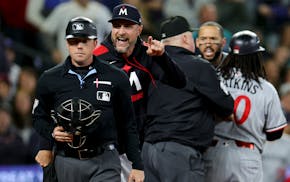
Twins' Correa ejected from on-deck circle, and he's not really sure why
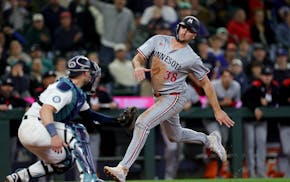
Twins' inability to score in extra innings costly in wild loss at Seattle
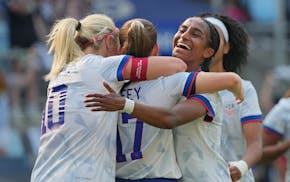
USWNT shuts out China 3-0 at Allianz Field
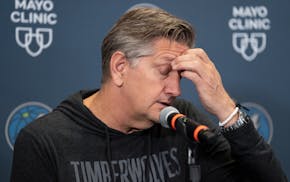
Analysis: The Wolves' offseason, broken down for easy consumption of a complicated topic
